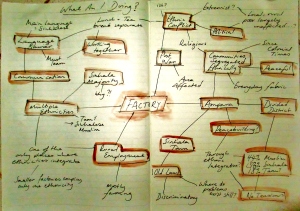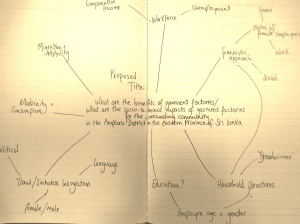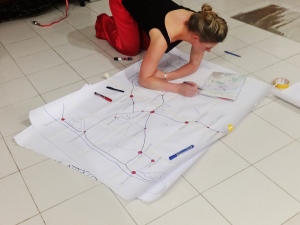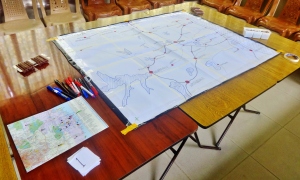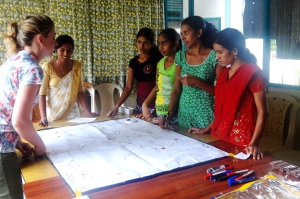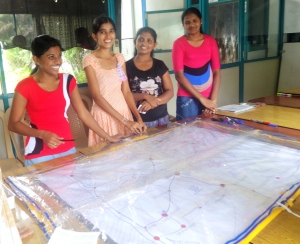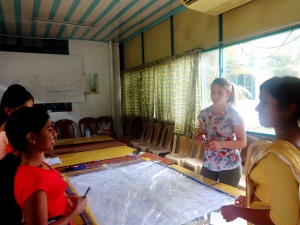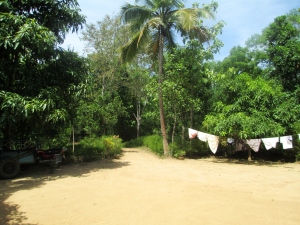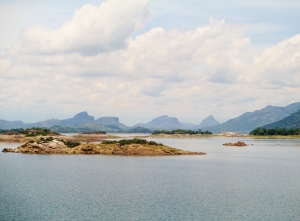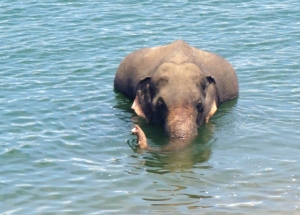It’s been a long and difficult afternoon of napping and thinking, napping some more, thinking a little more, and writing. But I feel it’s been useful.
I started out with a mind map:
And then moved on to write up ‘The Situation’:
• A large employment site, employing multiple ethnicities: Tamil, Muslim and Sinhalese work side by side in a garment factory in a rural area in post-war Sri Lanka. They usually choose to have their tea and lunch separately to one another. This is likely a language issue: the main language in the factory is Sinhalese. Most of the employees are Sinhalese.
• The factory is situated in Ampara Town. Ampara Town is about 97% Sinhalese. Old laws prohibit any other ethnicities from settling here or setting up businesses here. Very few of the factory employees live in the town itself.
• Ampara Town is the main town in Ampara District. According to 2007 statistics, the ethnic composition of the district is roughly 44% Muslim, 38% Sinhalese and 18% Tamil.
• The Eastern Province suffered, supposedly, during the 30 year long civil war, that ended in 2009. There are claims that ethnic tensions persist.
• Large employment sites such as the factory are amongst the only outlets in the district where ethnicities come into contact with one another. They do so peacefully and amiably, despite some language barriers. I am told there are no tensions between ethnicities. Any worker disputes are entirely unrelated to ethnicity.
• Meanwhile, peace building and reconciliation groups in Sri Lanka promote the importance of ethnic integration
• Yet the ethnic groups in Ampara District live peaceably apart.
• Settlements have been divided since their establishment, many of them dating back to centuries ago. The British colonisers and colonists play a large part in the settlement patterns in Ampara District.
• Despite alleged tensions between ethnicities, ethnic conflict of any sort does not appear to be present in the everyday fabric of the workers’ lives
• It would appear that the tensions are purely political, at a ‘higher’ level, as I’ve been told a number of times, the rural poor have more important things to think about, like how they will feed their families each day.
• So is ethnic integration through employment a good thing? Could it help with post war reconciliation? Is it needed at all?
• Is this… ‘an investigation into the importance/relevance/necessity of ethnic integration through employment in rural, post-war, Sri Lanka’?
Maybe.
So having summarised (and simplified) a lot, I have come up with the following:
Title:
An investigation into the importance/relevance/necessity [select your favourite or suggest another and we’ll roll with it] of ethnic integration through employment in rural, post-war, Sri Lanka
Research Questions:
What opportunities exist for ethnic integration in Ampara District, both at the workplace and in the wider community?
What is the ethnic distribution in Ampara District, and when do people of different ethnicities come into contact?
What ethnic tensions are present in Ampara District, where, and why, and what causes these to build to the point of conflict?
These questions should help me investigate the topic thoroughly and come up with some kind of answer as to how important ethnic integration in the workplace is, and why.
All of the above is entirely subject to change, as always. Although I’m leaving Sri Lanka in just a few days, I’ve barely skimmed the surface with all the literature there is out there to read, and I’ll be continuing a few threads of research too. But for now, it’s good to remind myself of where I am and what the point of my research is. My mother kindly mocked me earlier for having to ask myself what I’m doing, but it really is so important to keep track of things! Hence why I don’t feel one iota of guilt for having such a seemingly lazy afternoon.
Also, just for reference, here’s a mind map I made at the beginning of my research – look how much it’s changed!!

